Africa has more species of antelope than any other continent. Go on a safari and you don’t just see a few antelope – you encounter vast herds and a myriad of dazzling species.
But are there African deer as well?
Most people think not.
But there is one.
When many people think about African deer they are often confusing deer with antelope species such as springbok, eland and kudu.
However, there is a true African deer as well – the fabulous and highly endangered Barbary stag.
In this article we’ll celebrate the near extinct African deer as well as the most unique African antelope species.
Is There an African Deer?

Africa has dozens of different antelopes, such as sable, roan, impala, gemsbok and waterbuck.
It is also home to the Barbary stag, a red deer that is found in the mountain forests of Algeria, Tunisia and Morocco.
What is the Barbary Stag?
The Barbary stag (or Atlas deer) is Africa’s only true, native deer species. It lives in humid forests in the very north of Africa, with the largest population found in the Atlas Mountains.
With its magnificent jagged horns the Barbary stag makes quite an impression. It is part of the red deer species, which can also be seen across Central Asia, North Africa, Southern Europe, and the Caucasus.
Genetic studies disagree as to whether the Barbary stag is its own species or subspecies. One study argues that the African deer is indistinguishable from red deer that are found on the Italian islands of Sardinia and Corsica.
The study claims these red deer are native to North Africa and were introduced to the Mediterranean islands by people, so there is no difference between a Barbary stag and a Corsican red deer.
However, another study suggests that Africa’s only deer should belong to its own species, and not be a subspecies of the red deer at all.
Either way, it’s clear that the Barbary stag has more in common with its neighbors to the north than African antelope to the south.
Why is the African Deer Endangered?

The Barbary stag only has one predator – humans. They were hunted to extinction in Morocco and almost to extinction in Tunisia and Algeria.
Fortunately their population is currently increasing and the deer are now mostly found in protected national parks.
Roll back a few hundred years and these impressive deer were hunted by lions, leopards and the unique Atlas bear.
Unfortunately, Africa’s lion numbers have dropped from over 200 000 to just 23 000 over the last 60 years. Leopards have lost a huge percentage of their historic range.
Throughout the latter part of the 20th century Barbary stags didn’t need to fear stealthy cats, but bullets instead.
Who would hunt such a majestic animal?
We really don’t know either.
At Africa Freak we’re passionate about connection, not destruction.
But the African deer population has dropped enormously over the 19th and 20th centuries.
Where Can I See the Barbary Stag in the Wild?
Strangely enough, the best place to encounter an African deer is in a place where it was once extinct – the Middle Atlas mountains in Morocco.
Populations in Algeria and Tunisia are scattered across wild and mostly inaccessible woodlands, on the boundary between mountains and the Sahara. You would have to be very lucky to encounter one here.
Conservationists took a small population of Barbary stag from Algeria and reintroduced the species to Morocco, in the protected Tazekka National Park. Visit in winter and you may even spot an African deer standing in the snow!
Africa is Dominated by Antelope, Not Deer
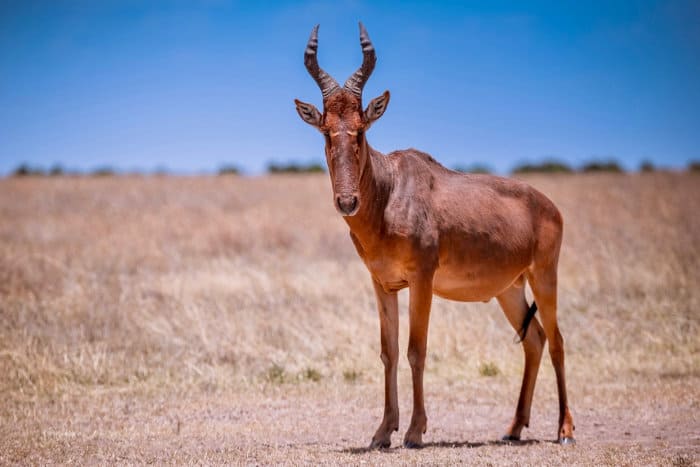
Most of Africa’s wilderness is dominated by antelope. You don’t just see one. They congregate in large herds and are the most common sight you will see on a safari.
Every landscape has a different cast as each antelope has its own specialism. For example, some prefer woodland while others graze on open grassland.
Before visiting Africa it’s easy to group them together as African antelope. But go on a safari and you’ll soon learn to differentiate kudu from eland from impala from oryx.
You’ll also appreciate all their unique evolutionary tactics. For example, the gerenuk has a giraffe-like neck so it can feed on branches other antelope can’t reach.
Never underestimate the size of antelope. While Thomson’s gazelle are small and dainty, many of these antelope species are much taller and heavier than we are.
Coming face to face with a hartebeest can be frightening when you’re on a walking safari.
Here are some of the more unusual African antelope and where you can see them.
Bongo

Bright orange in appearance with blazing white stripes, this critically endangered antelope is found in parts of Central Kenya and the Congo Basin.
Like bushbuck they are woodland dwellers. But very uniquely, female bongo also have impressive horns, rather than just the males.
Dik-Dik
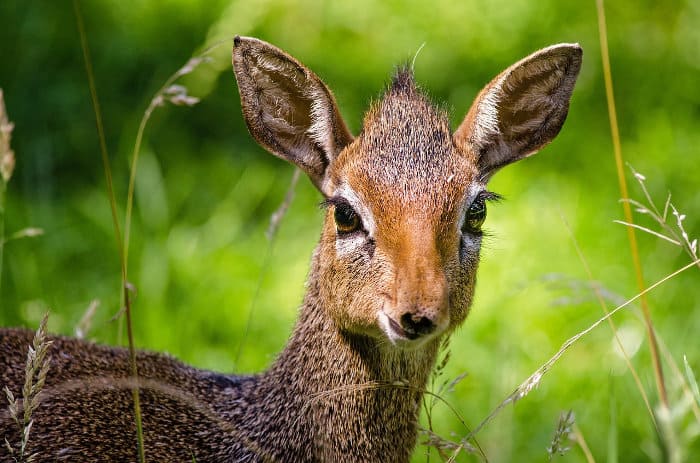
Africa’s small antelope is easy to miss. Dik-dik are widespread across Southern and East Africa, but they are so small they are usually completely covered by grass. Even certain large lizards prey on them.
Dik-dik are beautiful and monogamous – they form lifelong pairs and watch each other when grazing, so one is eating and one is on guard.
Gemsbok

The ringed horns of a gemsbok can grow to almost a meter in length. They rise straight and proud, with each ring an indication of the antelope’s age. Oryx have adapted to desert conditions and can roam great distances without water.
Spot gemsbok in Southern Africa, especially in countries like Botswana, Namibia, and South Africa.
Their close relative, the East African oryx, inhabit the Horn of Africa as well as southern Kenya and parts of Tanzania.
Gerenuk

Gerenuk are the giraffe of the antelope world. You can find them in Tanzania, Kenya and Ethiopia, stretching their necks to feed on arid landscapes.
Amazingly they don’t need to drink water at all – they take all the fluids they need from the vegetation.
Klipspringer

Skipping across the kopjes (rocky outcrops) of East and Southern Africa, klipspringer are the dancers of the antelope world.
Agile and nimble they live on harsh rock, which makes them a challenging catch for any predator.
Sable antelope
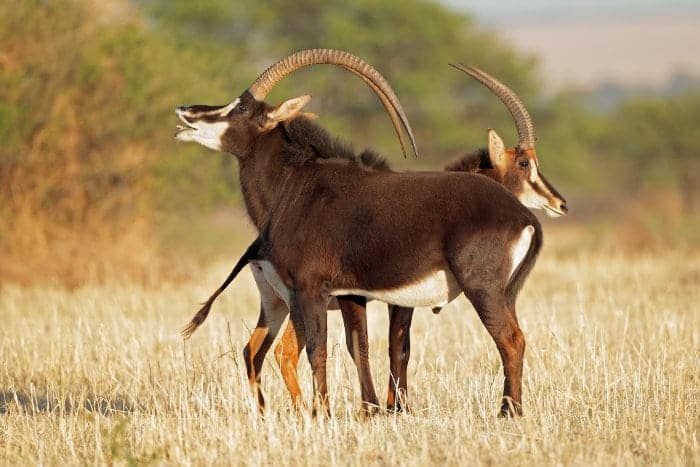
Shimmering fur and striking horns make sable one of Africa’s most revered antelope species. They are the sort of species that safari connoisseurs will look for when they return for a third or fourth time.
You can find them where woodland meets savanna. And they usually stare straight back at you, rather than running away.
Wildebeest

Incredibly abundant, blue wildebeest are the most famous African antelope. You can’t miss them in the Masai Mara or Serengeti, when they make their fabled annual migration.
What is your favourite African ungulate?
The African deer and all the African antelope are known as ungulates, essentially animals with hooves.
That is the same category as sheep, goats, pigs and cows.
So what is your favourite African ungulate?


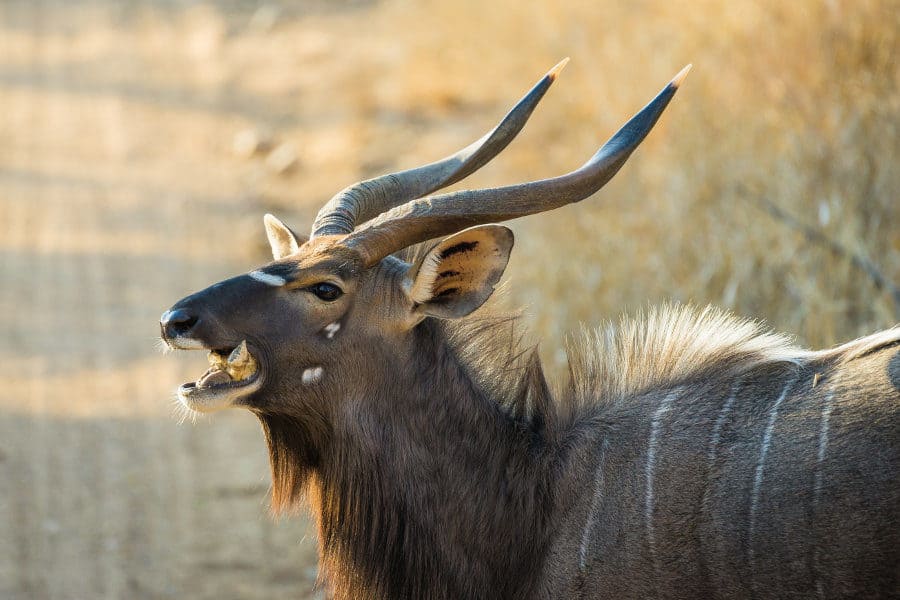
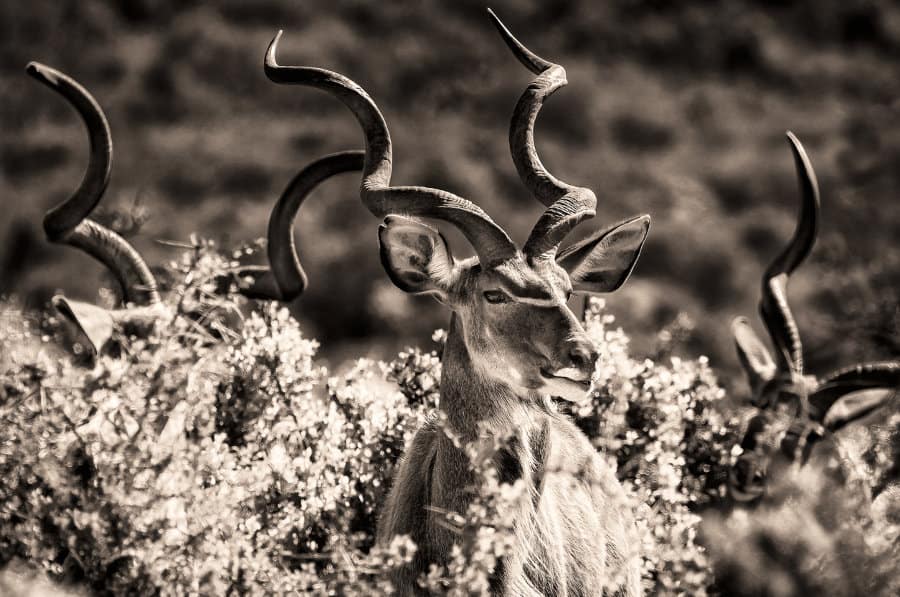
What is the fossil record like? Is it likely cwd took the cervids out of Africa, which would change the outlook for North America?
Love this article. Born in South Africa and loved the parks with wild animals. Miss that aspect of life over there. Knew of the tremendous variety of antelope and deer but not the story of their main location and habitat. So, thank you for the education.